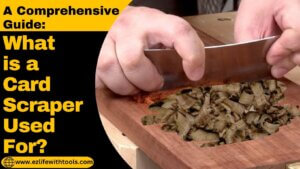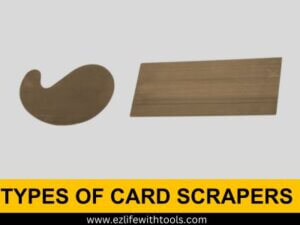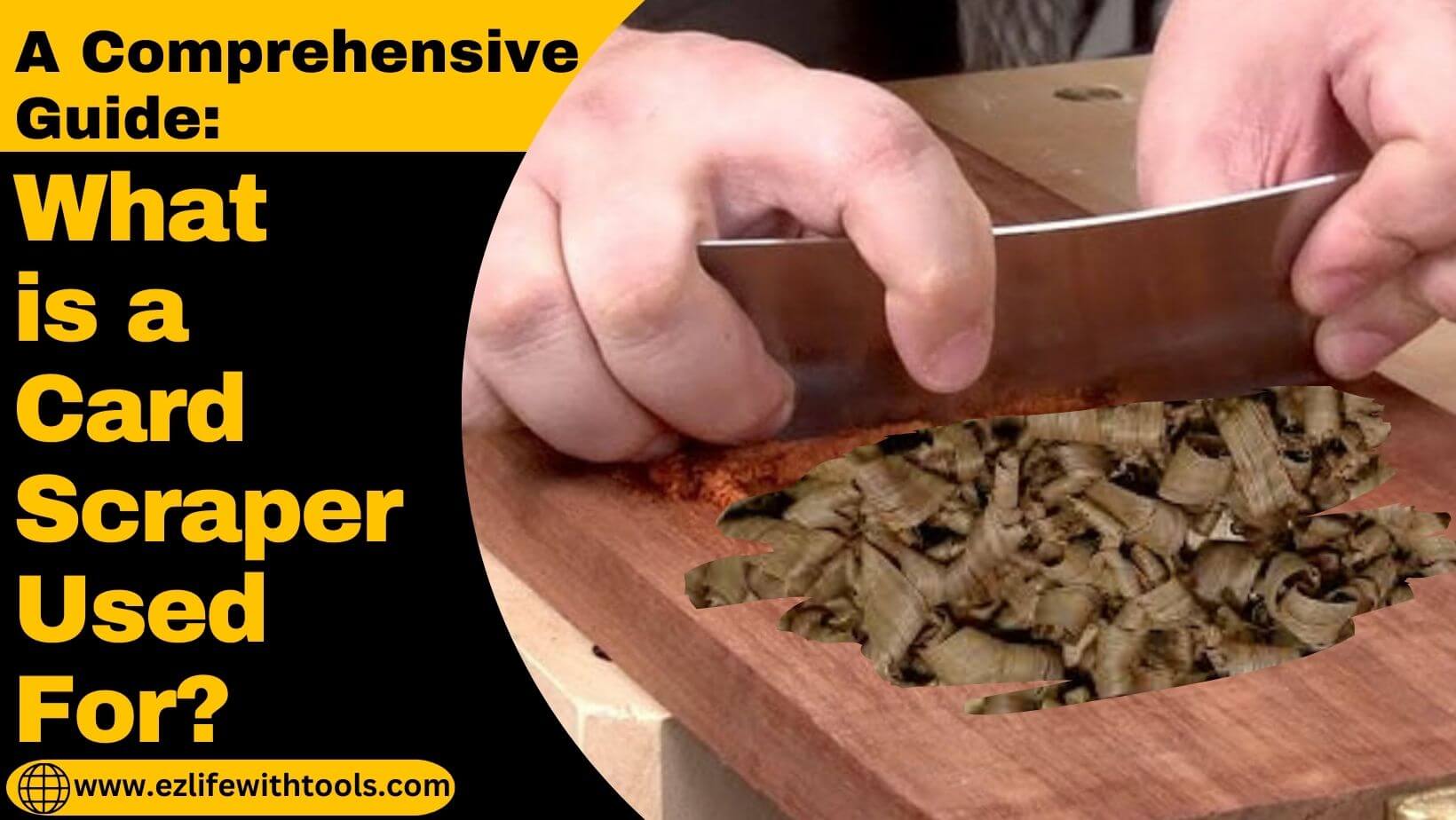A Comprehensive Guide: What is a Card Scraper Used For?
As its name sounds like a scraper, a card scraper is a simple and versatile tool that is used in woodworking,

having the ability to refine surfaces with precision.
Most beginners or some DIY enthusiasts don’t know about this and want to understand what is a card scraper used for.
If you also don’t know about it.
Don’t worry.
You are at the right place.
In this article, we’ll explain what card scrapers are, how they function, their types, and what effective techniques.
Understanding their role and mastering their techniques can elevate your woodworking endeavors to new levels of refinement and perfection.
What is a Card Scraper Used For wood?
It is a hand tool made of a thin, flat, and flexible metal blade. It looks like a simple flat metal plate, but it is sharpened to remove fine shavings of wood from a workpiece’s surface. Card scrapers delicately shear wood fibers, resulting in a pristine finish.
Types of Card Scrapers

Card scrapers come in various shapes, sizes, and thicknesses. All are designed to meet some specific needs. It
is necessary to understand the different types of card scrapers because you can choose the most suitable tools for your project according to your needs.
Basically, there are two types.
- Rectangular Card Scraper
- Curved Card Scraper
1- Rectangular Card Scraper
These are the most common types of card scrapers. They have a flat, straight-edged profile crafted from high-quality flexible steel.
Due to its flexibility, you will be able to shape the various surfaces of wood.
They come in different thicknesses, which helps to adjust the tool according to the specific requirements of the project.
Additionally, rectangular scrapers are relatively easy to sharpen and maintain.
2- Curved Card Scraper
A curved card scraper, also known as a gooseneck scraper. It has multiple curves in it. These multiple curves allow artisans to shape irregular and concave surfaces like chair legs, table edges, and complex moldings.
Because a rectangular scraper can’t address these surfaces wisely. Access concave or irregularly shaped surfaces that may be difficult to address with a straight-edged scraper.
The curvature of these scrapers enables woodworkers to navigate complex shapes and create smooth finishes on curved surfaces without causing unintended marks or scratches.
Why We Need a Card Scraper?
In the market, there are many tools like planes and sanders to create smooth finished surfaces of wood, but these traditional planes or sandpaper can sometimes cause tear-outs or leave undesirable marks.
Therefore, you can use card scrapers because they have the ability to create a glass-smooth surface on wood without the risk of tearing out or sanding marks.
Their ability to create refined surfaces makes them a favorite among woodworkers, furniture makers, and artisans alike.
When to Use a Card Scraper?
Understanding when and where to use a card scraper is essential to achieving flawless finishes and addressing specific challenges encountered during woodworking projects.
Smaller Pieces:
Card scrapers excel in refining smaller workpieces or intricate details where larger tools may prove inconvenient or less precise.
Difficult Situations:
In situations where tear-out occurs due to grain direction or challenging wood fibers, card scrapers offer a gentle yet effective approach to smoothen surfaces without exacerbating tear-out issues.
Bevels and Chamfers:
Crafting bevels or chamfers requires precision. Card scrapers allow woodworkers to achieve clean and consistent edges, enhancing the aesthetic appeal of furniture or woodworking projects.
Detail Clean Up:
After initial shaping or sanding, card scrapers refine surfaces, removing marks left by coarser tools and achieving a smoothness that sandpaper might struggle to attain.
Removing Old Finishes:
When refinishing furniture or restoring old wooden pieces, card scrapers are instrumental in removing old finishes, paint, or stubborn residues. Their precision allows for careful removal without damaging the underlying wood.
Effective Usage Techniques
To use the full potential of these tools and achieve superior results, understanding and implementing effective usage techniques are essential. Here are some essential points to remember.
- If you are using a card scraper without a holder, ensure a secure grip on the scraper.
- Apply consistent pressure to avoid erratic scraping or damage to the wood surface.
- Utilizing a scraper holder provides better control and minimizes hand fatigue during prolonged use.
- Make an angle of approximately 5-10 degrees between the scraper’s edge and the wood surface.
- Experiment with different angles to find the most effective setting for the specific wood species and grain orientation.
- Avoid excessive pressure, as it can cause chatter marks or digging into the wood.
- Utilize longer strokes across the wood grain to achieve evenness and consistent smoothing.
- Regularly check the surface for uniformity and make adjustments in pressure and angle as necessary.
- For curved or intricate surfaces, adapt the scraper’s angle and pressure to follow the contours smoothly.
Tips for Choosing a Card Scraper
Selection of the right card scraper depends on the consideration of various factors, like material, size, and quality. Understanding these factors helps to choose the appropriate scraper.
These are the factors to consider when purchasing card scrapers.
Material and Construction:
Material consideration is very important because a card scraper made of durable and high-quality material has the ability to retain an edge.
Especially consider the thickness and flexibility of the scraper, as these factors affect its adaptability and ease of use.
Variety of Sizes and Shapes:
Check different sizes and shapes of card scrapers to cater to various woodworking tasks.
Rectangular scrapers are ideal for larger surfaces, while curved scrapers excel in addressing contours and intricate shapes.
Quality of Edge and Finish:
Inspect the scraper’s edge for sharpness and consistency, ensuring it’s adequately honed for effective cutting.
Check for any imperfections or rough finishes on the scraper’s surface that might affect performance.
Research and Reviews:
Explore woodworking forums, reviews, and recommendations from experienced woodworkers to identify reputable brands or models.
Brands with a history of producing high-quality woodworking tools always offer reliable card scrapers.
Trial and Testing:
If possible, test different brands or models to assess their performance and feel in hand before making a purchase.
Personal preference plays a role, so experimenting with different scrapers aids in finding the most comfortable option.
Comfort and Ergonomics:
Choose a card scraper that feels comfortable to hold and maneuver, considering your hand size and grip preferences.
Ergonomic designs or scraper holders can enhance control and reduce hand fatigue during extended use.
Budget and Value:
Determine a budget while balancing the quality and value offered by different card scrapers.
Investing in a high-quality card scraper might yield better long-term results and durability.
Conclusion
Card scraper stands as a testament to woodworking finesse, offering unparalleled precision and control in achieving flawless finishes.
These unassuming tools, often overlooked, have the remarkable ability to transform wood surfaces with a level of refinement that surpasses conventional methods.
Mastering the art of the card scraper not only enhances woodworking prowess but also simplifies the process, delivering impeccable results across diverse projects.
In this comprehensive article, all the aspects are covered, such as how, when, and what is a card scraper used for.
I hope you enjoyed a knowledgeful journey with me.
Thank you for your time.
Best wishes

